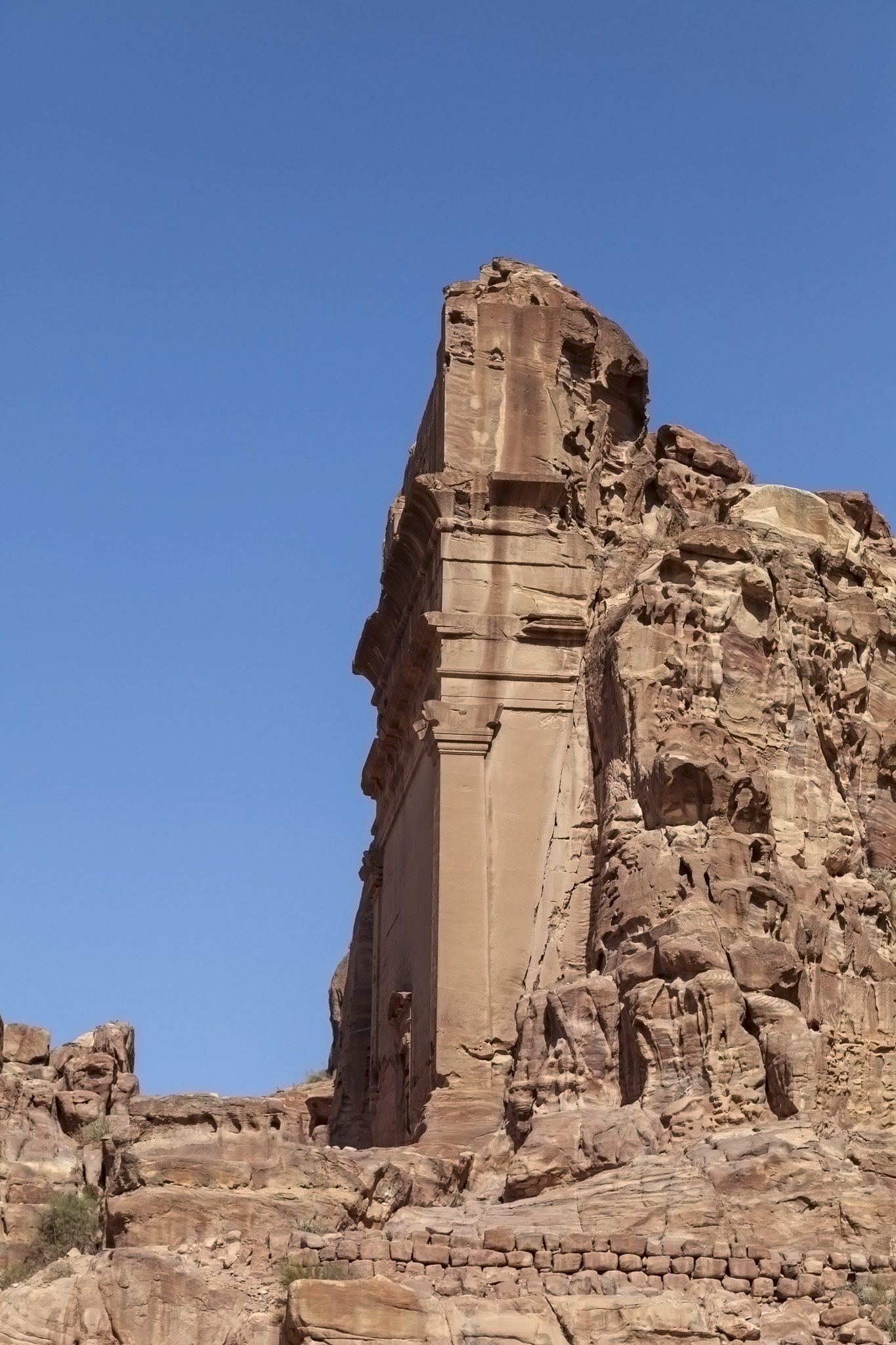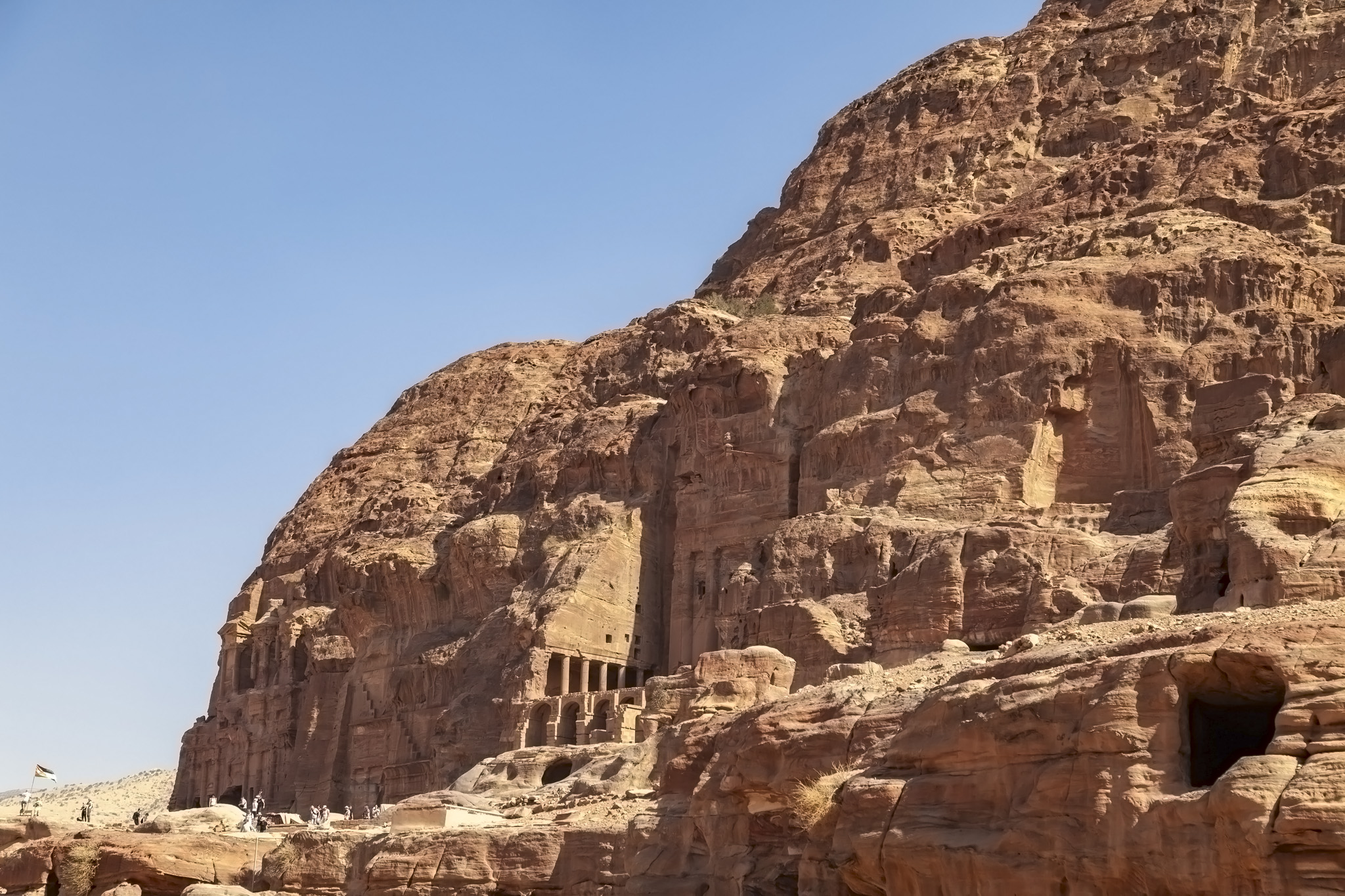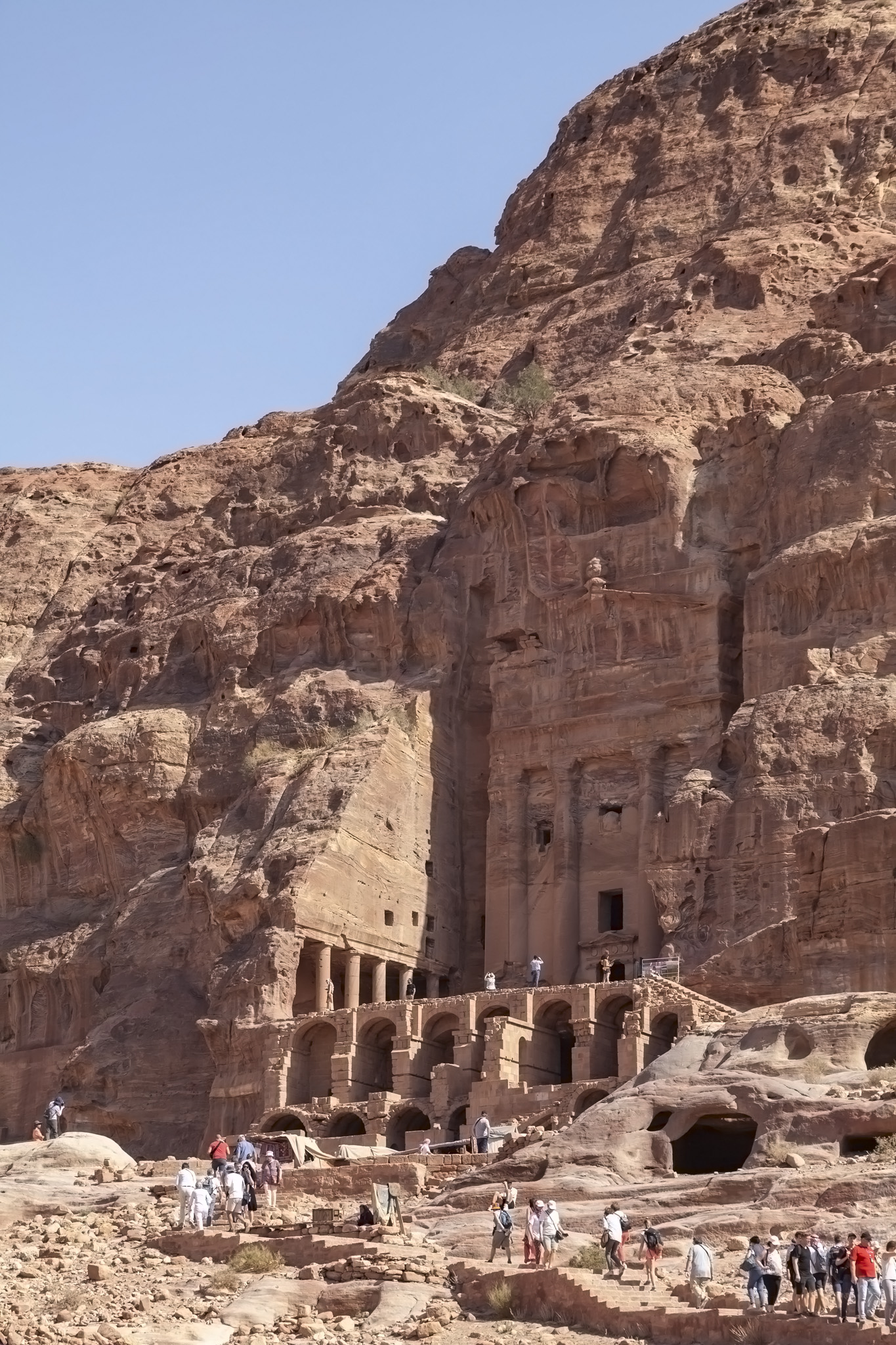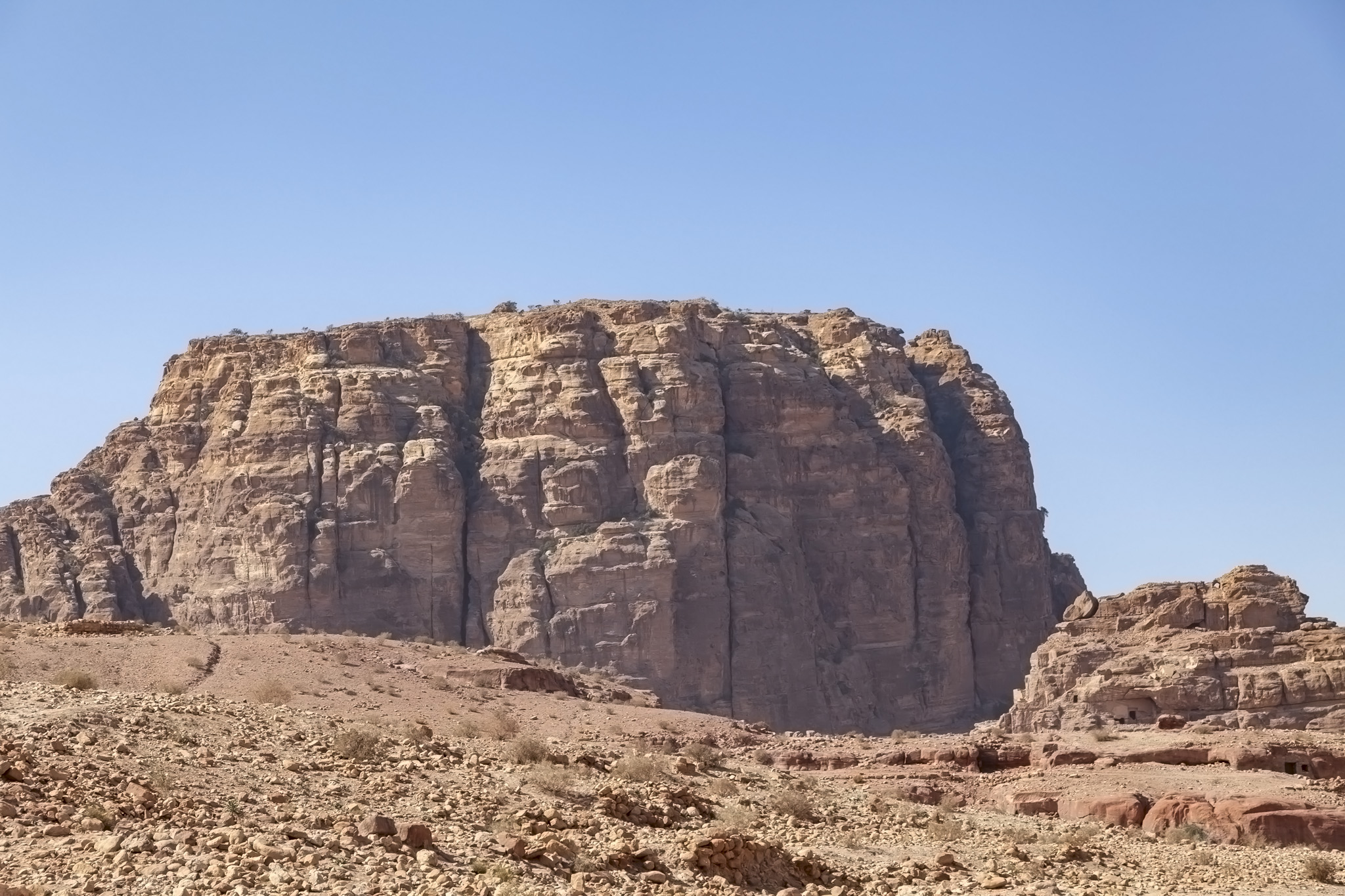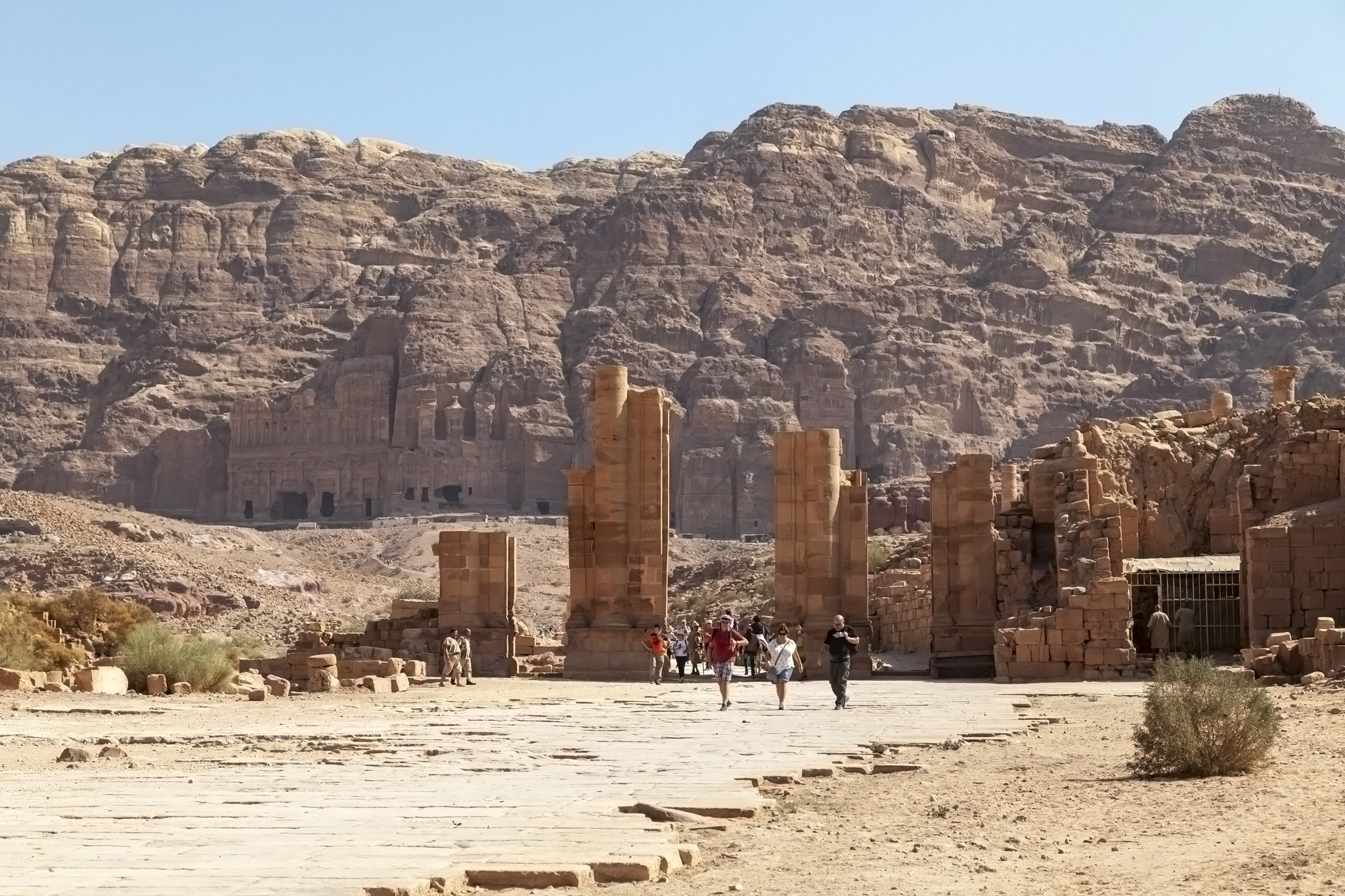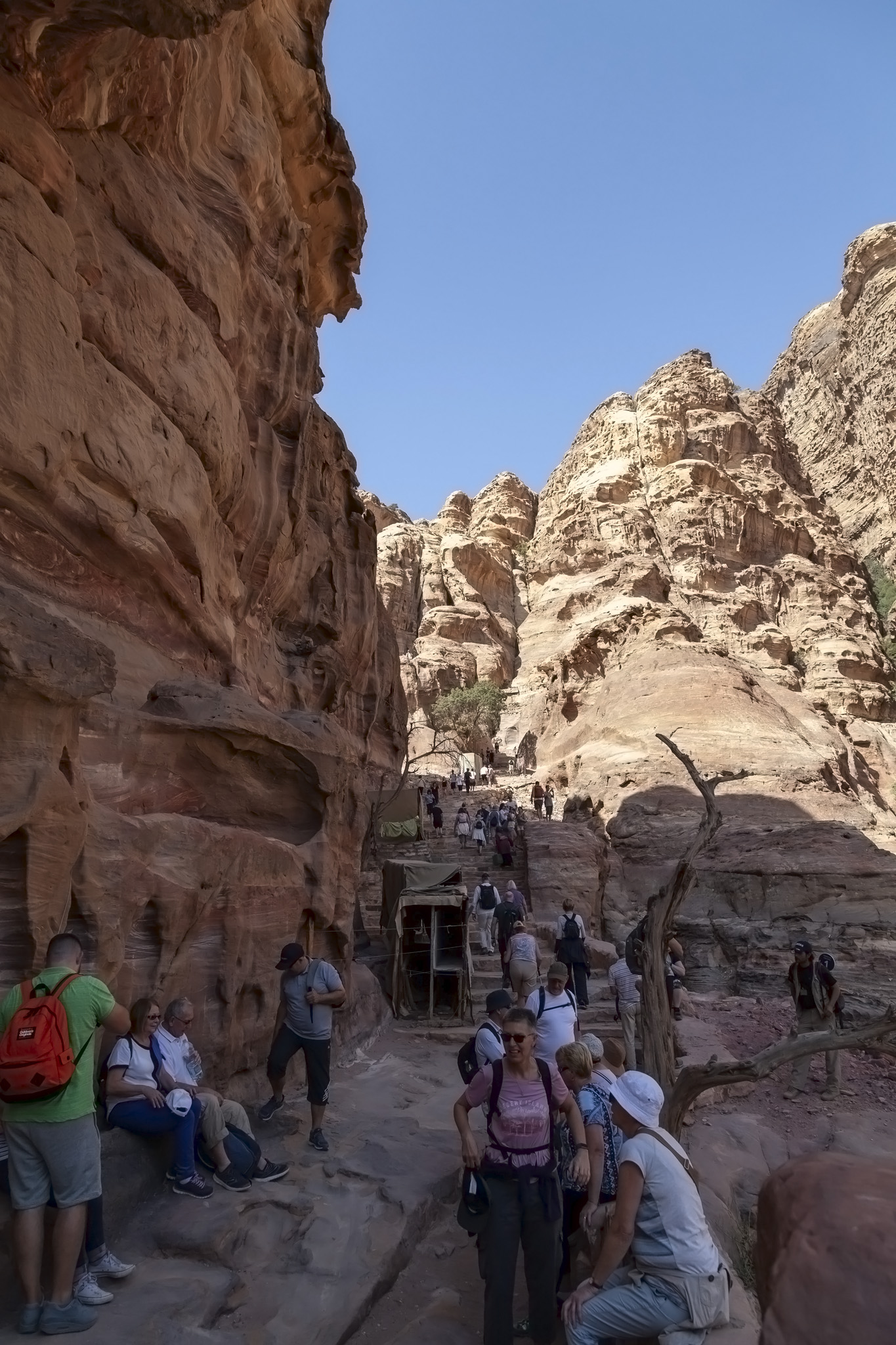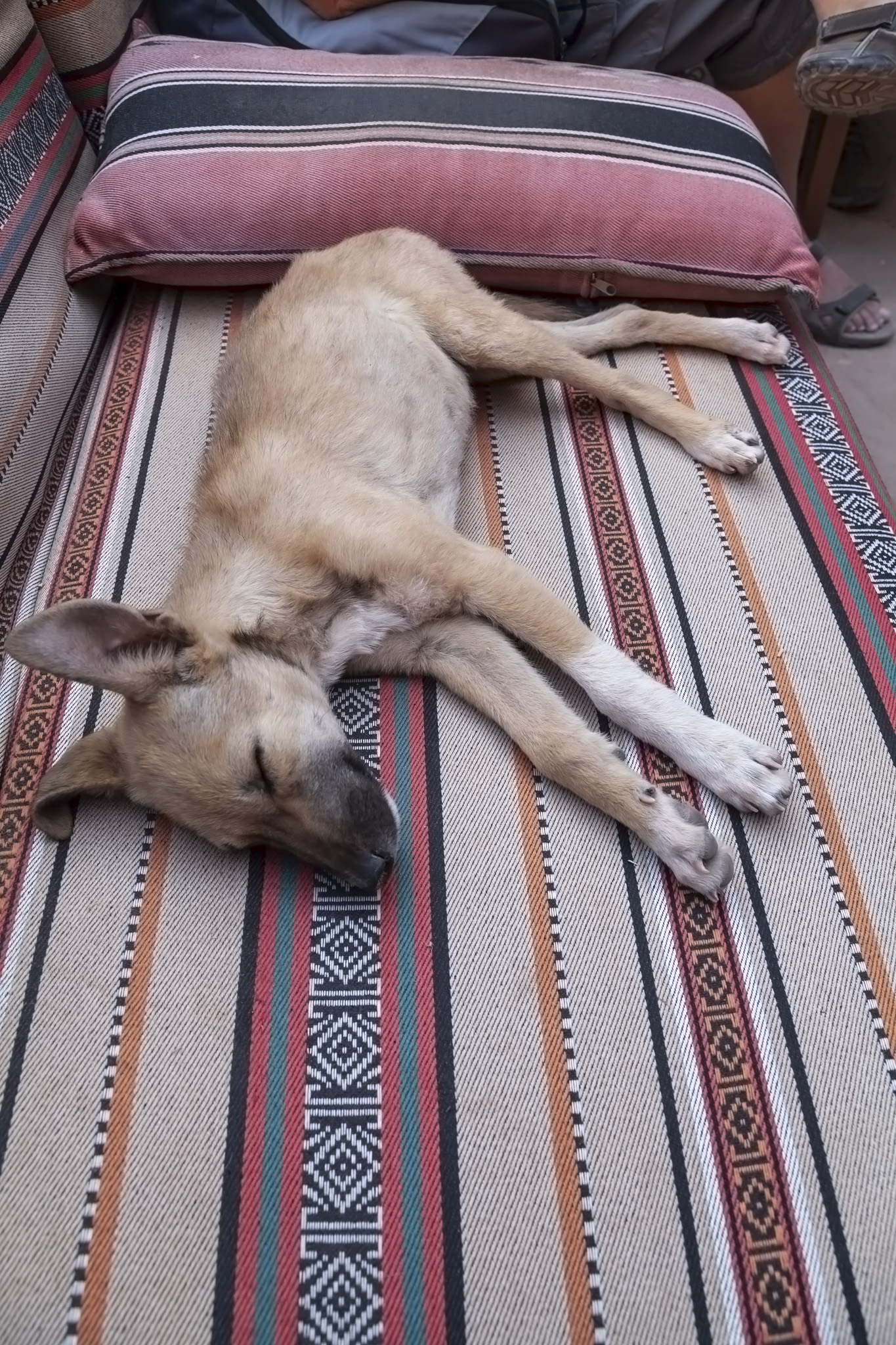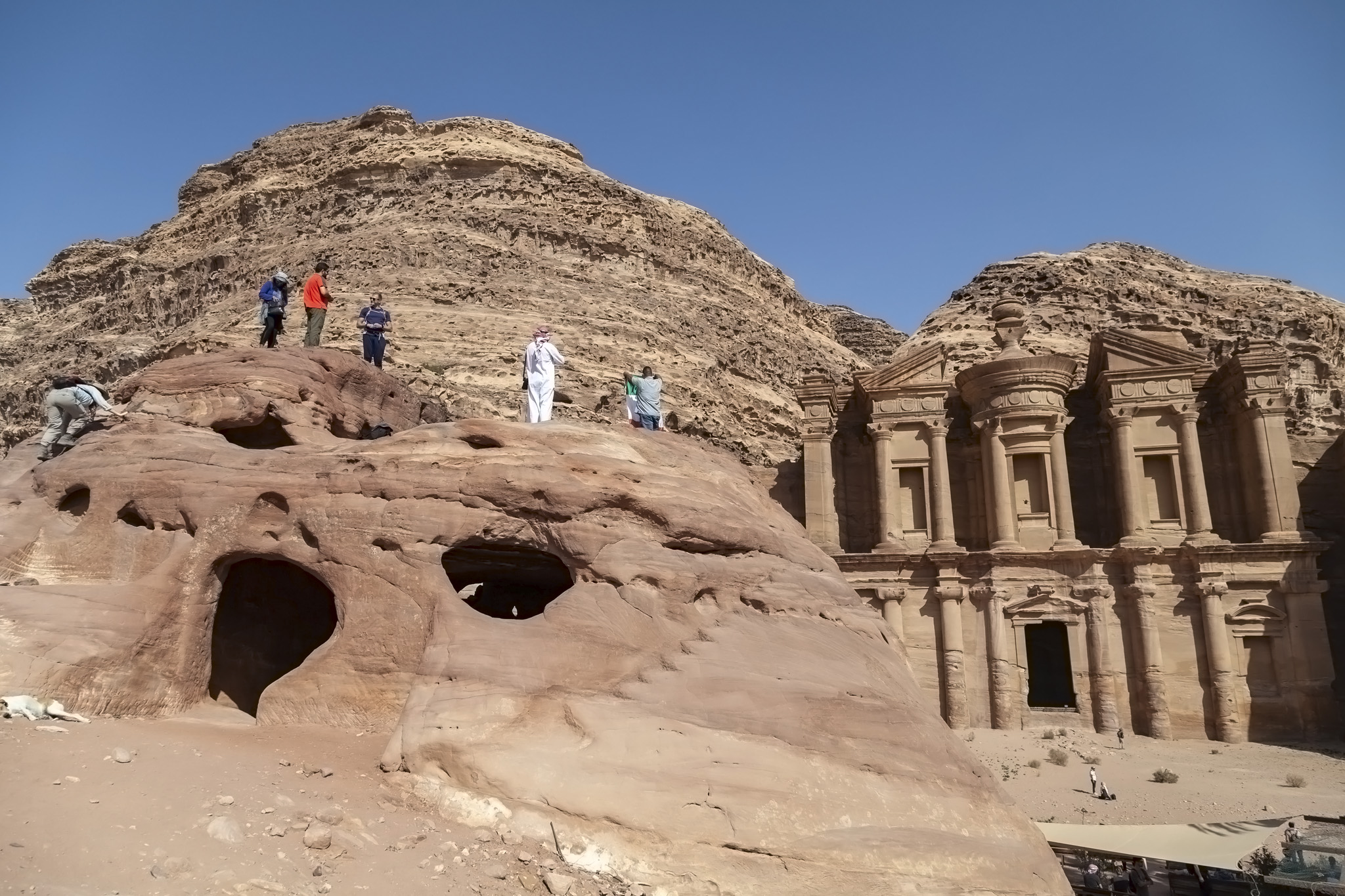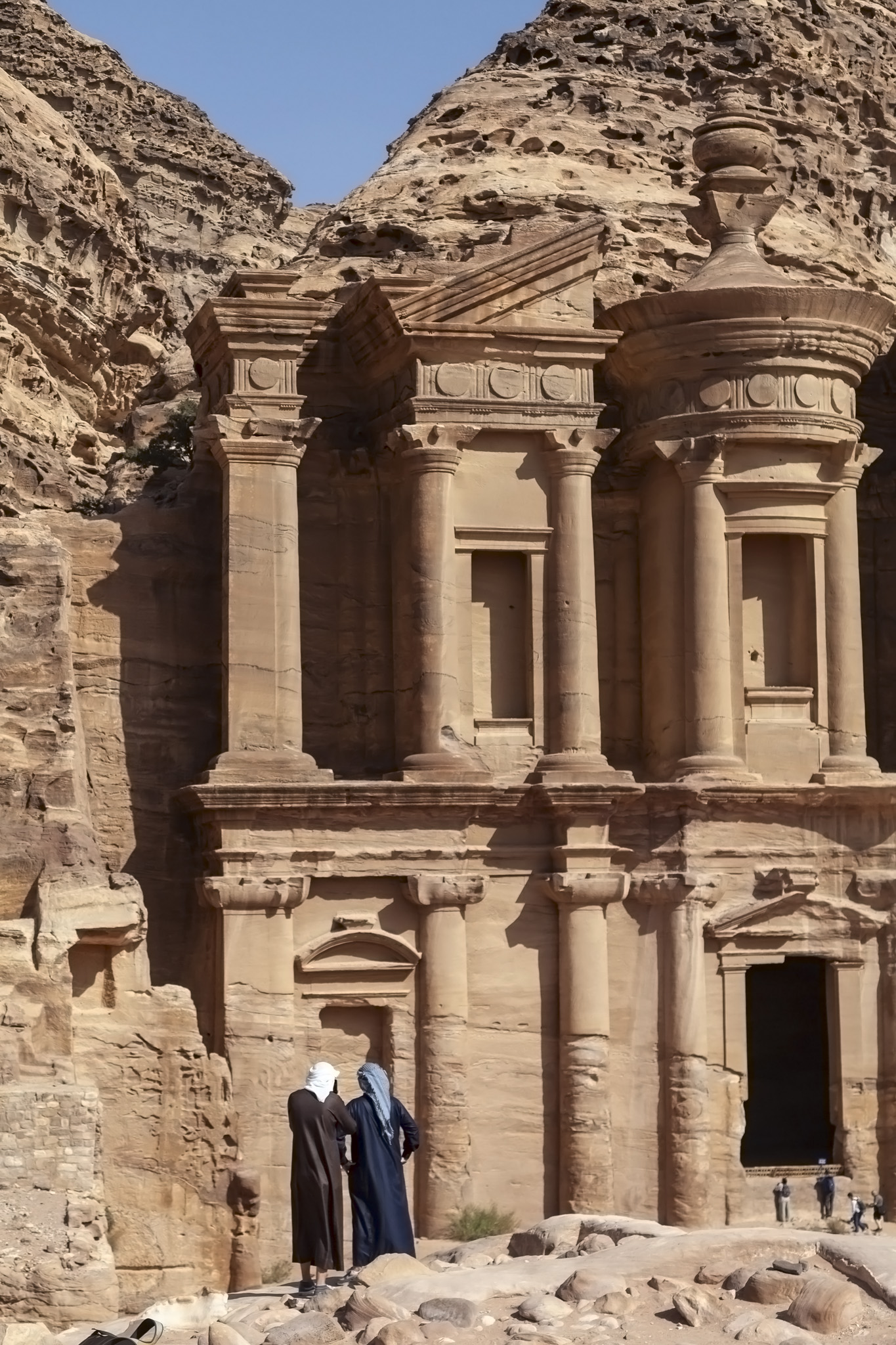Picking up right where we left off following our entry into Petra, walk through the Siq, and visit to the Treasury our guide gathered us together and set off at a fair pace through the Street of Facades in order to get us to the hiking portion of our cruise excursion as quickly as possible. Time was of the essence, he kept reminding us, as the hike would be a tough one and he wanted to make sure we could get to the Monastery and get back before the bus left. It was difficult to argue with his reasoning because as much as we enjoy travelling we don’t look so kindly on being stranded anywhere.
The Street of Facades is a wide area beyond the Treasury with numerous Nabataean tombs and Nabataean decorations on them in their typically grand scale. The placing of tombs doesn’t reflect the age of when they were constructed or any real significance with the person entombed as the tombs were simply produced in the most suitable sandstone spots at the time.
A lot of the damage on the tombs is natural so possibly the most distinctive of those in this part of Petra was the Aneisho Tomb which seemed to be standing separately and withstanding the assault of time better than others around. The tomb includes features in Greek and Egyptian styles, was built for the minister of Queen Nabatiyeh Shaqilh II, and its interior is split over two levels and covers around four hundred square metres in area.
Carrying on our walk we next came to the Theatre. Built early in the first century CE like most of the more impressive architectural feats in Petra and later modified during Roman rule, this was nevertheless a distinctly Nabataean theatre on account of it being carved out of the surrounding sandstone rather than constructed independently in the Greek or Roman manner. Its location was picked to have the best view of most of the more impressive tombs leading up to it and its capacity is estimated at around eight and half thousand people. A couple of days after our visit to Petra we would visit Chester which also has ruins of an ancient theatre and I can assure you that the one at Petra is a smidge more impressive. Maybe even a tad more than a smidge.
A little further along from the theatre was a place to stop and simply admire the views for a while as those who needed to use the toilets could do so at a spot in front of the Royal Tombs where a number of shops and stalls were set up. The tombs looked particularly impressive and if we return to Petra at some point then I’d certainly like to explore them but on this trip we were too limited for time.
The main walking trail in Petra then curved to the west and took us down the Colonnaded Street. This would have been the main shopping street in the city with a large market area to the south. The street includes drainage channels under its curved shape to remove excess water from rains and while it was originally Nabataean it had clearly been improved upon and rebuilt during the period under which Petra was ruled from Rome.
The Colonnaded Street took us to a structure that didn’t look that impressive but which was the Temple of Qasr Al-Bint, one of the most intact buildings in Petra and still standing at its full height despite seismic activity in the area. From the perspective of our excursion, though, this was an important location that indicated the last bit of flat ground we’d have for a while as it also signified we had reached the start of our hiking trail.
And so, with a final gathering together and some words of encouragement from our guide – “This will be hard work and I will push you to get you up as quickly as possible. Please let me know if you feel ill at any point” – (okay, not exactly words of encouragement) we started our hike to the Monastery.
If you read about it ahead of time, even if you read it here, then you know that the Ad-Deir Trail (the hiking trail to the Monastery) consists of approximately eight hundred steps. But that doesn’t mean you’ll take eight hundred steps to ascend because there are long, sloping sections in between the steps. And that doesn’t account for the fact that some of those steps are steps in the loosest definition possible. And the steps are covered in sand and stones in places. And they’re different heights and angles. And some areas have sheer drops near them. And donkeys thunder past every couple of minutes. And donkeys are wider than you realise. And donkeys don’t care about you.
It is, in short, not an easy hike, and if you’re the wife of someone writing this who just happens to have old injuries to her ankle and knee to contend with plus a fear of any unstable surface under her (edge of a cliff: fine; stand on a foot stool: palpitations) then it’s a horrible hike. I very quickly saw that my wife was experiencing a panic attack on the ascent and I think it was pretty obvious to most of our tour group that she was struggling too. In fact, at one point heading up we passed a French group coming down and one woman in there approached us to say there wasn’t much further to go and we could do it so it was even obvious to kind but complete strangers passing fleetingly. Of course I offered to stop the hike because that’s what a caring husband does but I also only offered once because that’s what a caring husband who receives the Glare of Impending Homicide If You Ask That Question Again does.
Our guide was true to his word and kept urging us all on but we did stop three times briefly up the enclosed trail to rehydrate. Out of necessity because of the time we’d arrived and would need to depart we were probably hiking up the trail at the worst time of day with long sections in full sunlight so it was hot, but probably because of the time of year not terribly so; it was considerably hotter when we’d hiked in Nicaragua earlier in the year, for example. Even still, we were very glad to have packed some wet wipes with us as their cool dampness helped to bring down our temperatures quite nicely during those moments of respite on the climb.
And so I shall let the pictures do the talking for the hike up the trail to the Monastery at Petra now. You’ll see how there are sections of flattish ground between the steps and see how the trail zig-zags back on itself in places. You will also be able to get a feel for the narrowness of the trail and height of the surrounding walls of sandstone at parts along the hike as we made our way to the summit.
From the start of the hike to reaching the plateau at the end took us just under an hour. What greeted us was definitely worth the trek.
Despite its name, the Monastery was most likely a temple or tomb (those Nabataeans really liked their tombs) to a king, Obadas, who was later deified. The fantastic facade is fifty metres wide and almost as tall. If you’re visiting Petra and you think you can do it then the hike to the Monastery is highly recommended by us.
The wide plateau in front of the Monastery was artificially created by the Nabataeans for social and ritualistic gatherings and in more recent times, as you’ll see from the video above, rest facilities have been established. After a short gawp at the Monastery we headed to the café to get some more water as we’d almost depleted everything we’d brought with us on the hike. Other people were eating as they – as well as cats and dogs – were sheltering in the seated section of the cave adjoining the café but we were content to just get some liquid inside us.
It didn’t take me long to recover but I wasn’t fighting an hour’s worth of panic-attack-induced adrenalin coursing through my system so I left my wife to rest a little longer while I took a walk around the area for some more photos. Behind the café was a raised area of ground affording better views of the impressive Petra building and which included some rock mounds with hollowed out rooms and windows carved into them. There was also an area up another set of steps that claimed to offer a fabulous view to the west over the Jordanian landscape but I wasn’t sure if I’d have the time to make it up and back without my wife worrying so satisfied myself with some pictures of the people and sights more close by.
When we checked the time we realised that we had plenty of it left. We have to thank our guide for that because his constant pushing for us to complete the hike meant we could really relax if we wanted from this point on. We could probably have stayed around the Monastery for another forty five minutes if we’d really wanted before starting on the way back but we decided we’d make our return ahead of everyone else in order to be able to take our time going down – those fears of my wife and her issues with the uneven terrain would return just as much on the way down as on the way up – and potentially explore some of the areas we’d passed on the walk through Petra to the hiking trail.
It would transpire that something would distract us from exploring more of Petra’s ruins on this visit. Something wonderful. You can find out what that was in the final part of this travelogue series covering our cruise excursion to Petra which takes us from the Monastery back down to ground level and out of the fabulous Jordanian city.








